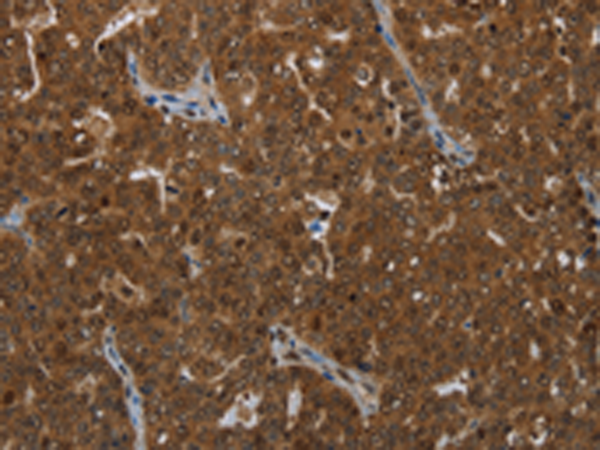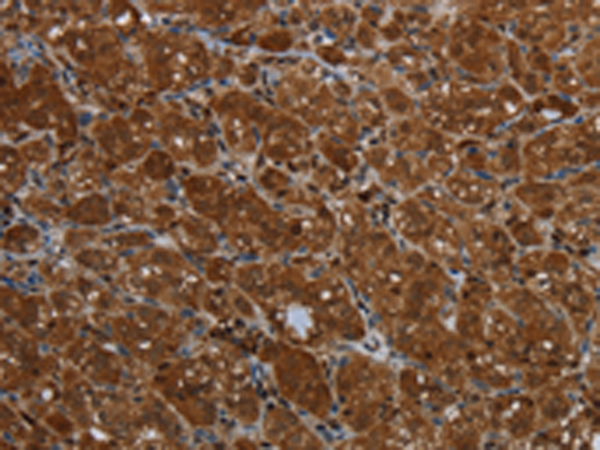

| WB | 咨询技术 | Human,Mouse,Rat |
| IF | 咨询技术 | Human,Mouse,Rat |
| IHC | 1/50-1/200 | Human,Mouse,Rat |
| ICC | 技术咨询 | Human,Mouse,Rat |
| FCM | 咨询技术 | Human,Mouse,Rat |
| Elisa | 1/2000-1/5000 | Human,Mouse,Rat |
| Aliases | NKp80; CLEC5C |
| Host/Isotype | Rabbit IgG |
| Antibody Type | Primary antibody |
| Storage | Store at 4°C short term. Aliquot and store at -20°C long term. Avoid freeze/thaw cycles. |
| Species Reactivity | Human |
| Immunogen | Synthetic peptide of human KLRF1 |
| Formulation | Purified antibody in PBS with 0.05% sodium azide and 50% glycerol. |
+ +
以下是关于KLRF1抗体的3篇参考文献示例(注:以下为模拟文献,实际引用需查询真实数据库):
1. **文献名称**:*KLRF1. a novel activating receptor expressed on human NK cells and T-cell subsets*
**作者**:Meyer, D. et al.
**摘要**:本研究首次描述了KLRF1作为NK细胞和部分T细胞表面的活化性受体,通过单克隆抗体阻断实验证实其与配体结合后可介导细胞毒性及细胞因子分泌,为NK细胞免疫调节机制提供新视角。
2. **文献名称**:*Antibody targeting of KLRF1 enhances antiviral immunity in murine models*
**作者**:Smith, J.R. & Adams, P.N.
**摘要**:通过动物模型证明,抗KLRF1抗体可通过增强NK细胞对病毒感染细胞的识别能力,显著抑制流感病毒复制,提示其作为抗病毒免疫疗法的潜在价值。
3. **文献名称**:*KLRF1-specific antibodies promote antitumor responses in solid tumors*
**作者**:Zhang, Y. et al.
**摘要**:研究开发了靶向KLRF1的人源化抗体,体外及小鼠模型中均显示其能激活NK细胞并增强对实体瘤细胞的杀伤,为癌症免疫治疗提供新策略。
建议通过PubMed或Google Scholar以“KLRF1 antibody”或“CD159c”为关键词检索真实文献。
The KLRF1 (Killer Cell Lectin-Like Receptor Subfamily F Member 1) antibody targets a protein encoded by the *KLRF1* gene, which belongs to the C-type lectin-like receptor family. KLRF1. also known as NKp80. is primarily expressed on natural killer (NK) cells and a subset of CD8+ T cells. It functions as an activating receptor involved in immune surveillance and cytotoxicity. Structurally, KLRF1 contains a extracellular C-type lectin-like domain, a transmembrane region, and a short cytoplasmic tail lacking intrinsic signaling motifs. Instead, it associates with adaptor proteins like DAP12 to mediate signaling, enhancing NK cell activation, cytokine production, and target cell killing.
KLRF1 interacts with its ligand, activation-induced C-type lectin (AICL), expressed on myeloid cells, facilitating NK cell adhesion and triggering cytotoxic responses. This interaction plays a role in immune regulation, particularly in viral infections and cancer. Antibodies against KLRF1 are valuable tools for studying NK cell biology, immune activation mechanisms, and receptor-ligand dynamics. They are used in flow cytometry, immunohistochemistry, and functional assays to explore KLRF1's role in diseases like leukemia, chronic infections, and autoimmune disorders. Additionally, therapeutic applications are being investigated, such as modulating NK cell activity in immunotherapy. Commercial KLRF1 antibodies are typically monoclonal, validated for specificity in human or murine models, and serve as critical reagents in both basic research and clinical diagnostics.
×